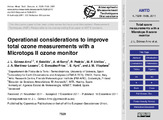Por favor, use este identificador para citar o enlazar este ítem:
http://hdl.handle.net/20.500.11765/7543
Operational considerations to improve total ozone measurements with a Microtops II ozone monitor [Discussion paper]
| Título : | Operational considerations to improve total ozone measurements with a Microtops II ozone monitor [Discussion paper] |
| Autor : | Gómez Amo, José Luis; Estellés Leal, Víctor; Di Sarra, Alcide Giorgio; Pedrós, Roberto; Utrillas, María Pilar; Martínez Lozano, José Antonio; González Frías, Carlos; Kyrö, Esko; Vilaplana Guerrero, José Manuel |
| Palabras clave : | Ozone monitor; Ultraviolet solar radiation; Total column ozone; Sunphotometer; Microtops II |
| Fecha de publicación : | 2011 |
| Editor: | European Geosciences Union |
| Citación : | Atmospheric Measurement Techniques Discussions. 2011, 4, p. 4, 7529–7558 |
| Versión del editor: | https://dx.doi.org/10.5194/amtd-4-7529-2011 |
| Resumen : | A Microtops II “ozone monitor” with UV channels centered at 305.5, 312.5, and 320 nm has been used routinely in six experimental campaigns carried out in several geographic locations and seasons, covering latitudes from 35 to 68◦ N during the last ten years (2001–2011). The total ozone content is retrieved by Microtops II by using different combinations (Channel I, 305.5/312.5 nm; Channel II, 312.5/320 nm; and Channel III, 305.5/312.5/320 nm) of the signals at the three ultraviolet wavelengths. When a calibration was used and the airmass limit was fixed to 3, Microtops II produce mean relative deviations with respect to the Brewer of 0.1, −11, and 8 % respectively for the Channel I, Channel II, and Channel III retrieval. The performance of the Microtops retrieval has been stable during the last ten years. Channel I represents the best option to determine the instantaneous total ozone content. Channel II and III values appear weakly sensitive to temperature, ozone content, and aerosols. Channel II is more stable than Channel I for airmasses larger than 2.6. The conclusions do not show any dependence on latitude and season. |
| Patrocinador: | This study was possible thanks to a postdoctoral fellowship funded by the Generalitat Valenciana in the case of J. L. Gomez Amo (in the framework of “Estancies post- doctorals en centres de Excellencia de la Comunitat Valenciana” programme) and a Juan de la Cierva research contract (JCI-2009-04455) in the case of V. Estellés, funded by the Spanish Ministry of Science and Innovation (MICINN). This work was also supported by the MICINN projects CGL2007-60648 and CGL2009-07790, and by the Valencian Autonomous Government through the Project PROMETEO/2010/064. |
| URI : | http://hdl.handle.net/20.500.11765/7543 |
| ISSN : | 1867-8610 |
| Colecciones: | Artículos científicos 2010-2014 |
Ficheros en este ítem:
| Fichero | Descripción | Tamaño | Formato | ||
|---|---|---|---|---|---|
| amtd-4-7529-2011.pdf | 3,64 MB | Adobe PDF |  Visualizar/Abrir |
Los ítems de Arcimis están protegidos por una Licencia Creative Commons, salvo que se indique lo contrario.





